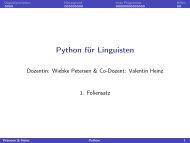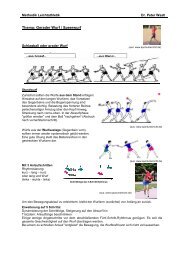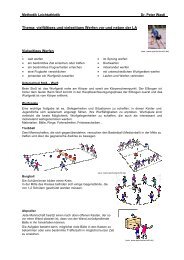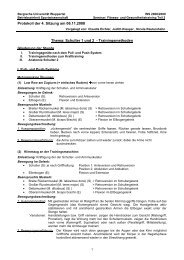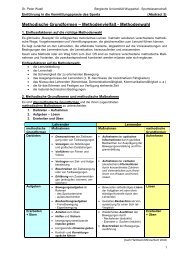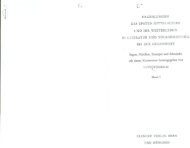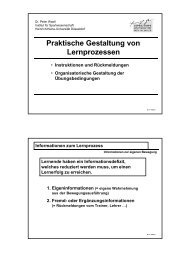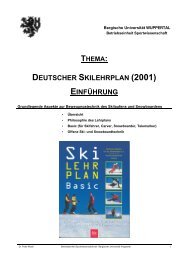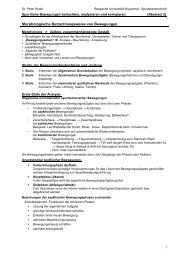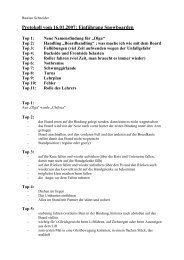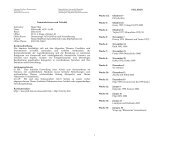Corpus-based Acquisition of Complex Negative Polarity Items
Corpus-based Acquisition of Complex Negative Polarity Items
Corpus-based Acquisition of Complex Negative Polarity Items
Create successful ePaper yourself
Turn your PDF publications into a flip-book with our unique Google optimized e-Paper software.
<strong>Corpus</strong>-<strong>based</strong> <strong>Acquisition</strong> <strong>of</strong><br />
<strong>Complex</strong> <strong>Negative</strong> <strong>Polarity</strong> <strong>Items</strong><br />
Timm Lichte<br />
Collaborative Research Centre 441 — University <strong>of</strong> Tübingen<br />
timm.lichte@student.uni-tuebingen.de<br />
Abstract. This paper presents the functionality and results <strong>of</strong><br />
an extraction mechanism for German negative polarity items (NPIs)<br />
which uses a large partially parsed corpus <strong>of</strong> written German and<br />
integrates usual collocation acquisition methods. Particular attention<br />
is paid to the extraction <strong>of</strong> complex NPIs.<br />
1 Introduction<br />
In this paper I will address a special group <strong>of</strong> lexical elements which show a<br />
particular affinity with negative contexts. Such elements, usually referred to<br />
as negative polarity items (NPI), have been widely studied in the linguistic<br />
literature since Klima (1964). The classic example <strong>of</strong> an NPI is the English<br />
indefinite determiner any. As demonstrated in (1) a sentence containing<br />
any and negation is grammatical. Without the negation the sentence is<br />
ungrammatical. Following standard terminology I will refer to the negation<br />
as the licenser <strong>of</strong> the NPI. I will underline NPIs and print the licensers in<br />
bold face. 1<br />
(1) a. He hasn’t seen any students.<br />
b. *He has seen any students.<br />
Since I will be focusing on German, an analogous German example is presented<br />
in (2). These sentences differ only in that sentence (a) contains a<br />
1 There is a particular use <strong>of</strong> any, called free-choice any, which does not require a<br />
negative operator such as not. Nevertheless this use has a restricted distribution, i.e. it<br />
requires a context which is nonveridical (Zwarts (1995),see Section 2).<br />
Proceedings <strong>of</strong> the Tenth ESSLLI Student Session<br />
Judit Gervain (editor)<br />
Chapter 14, Copyright c○ 2005, Timm Lichte<br />
157
so-called n-word as licenser, whereas in (b) there is no exponent <strong>of</strong> negation;<br />
thus the NPI jemals (ever) is not licensed.<br />
(2) a. Niemand von uns war jemals im Jemen.<br />
nobody <strong>of</strong> us was ever in Yemen<br />
(None <strong>of</strong> us has ever been to Yemen.)<br />
b. *Einer von uns war jemals im Jemen.<br />
One <strong>of</strong> us was ever in Yemen<br />
The inventory <strong>of</strong> NPIs in English and Dutch has been documented fairly well.<br />
Jack Hoeksema (pc) has collected about 760 Dutch NPIs. For German the<br />
state <strong>of</strong> documentation is less ideal. There are only two relatively extensive<br />
lists: Welte (1978) and Kürschner (1983), neither <strong>of</strong> which comes even close<br />
to the data collected by Hoeksema.<br />
The aim <strong>of</strong> this paper is to present a step towards an automatic corpus<strong>based</strong><br />
compilation <strong>of</strong> a list <strong>of</strong> German NPI candidates. To my knowledge<br />
van der Wouden (1992) was the first to explicitly point out that the relation<br />
between an NPI and its licenser bares similarities to the relation between<br />
a collocate and its collocator. This idea, then pursued in van der Wouden<br />
(1997), represents the basic motivating insight for this paper.<br />
In Section 2 I will summarize the semantic literature on NPIs. These<br />
insights are applied to extract NPI candidates consisting <strong>of</strong> a single lexical<br />
element in Section 3, and in Section 4 to extract complex NPI candidates.<br />
2 Linguistic Aspects<br />
In this section I will present a summary <strong>of</strong> those aspects <strong>of</strong> NPIs which are<br />
directly related to our study.<br />
Negation is understood as a logical operator which imports special entailment<br />
properties to the semantic value <strong>of</strong> an attached sentence. The literature<br />
on NPIs distinguishes several degrees <strong>of</strong> negativity <strong>based</strong> on their<br />
formal semantic properties. 2 I will concentrate on operators which are downward<br />
entailing to identify negative contexts. Since downward entailment is a<br />
rather general property <strong>of</strong> negative contexts and since all stronger degrees <strong>of</strong><br />
negativity conform to downward entailment, operators <strong>of</strong> stronger negation<br />
are also included. As has been noted by Ladusaw (1980) most NPIs require<br />
a context which is at least downward entailing. Genuine downward entailing<br />
operators include words such as höchstens (at most), kaum (hardly) or<br />
2 See van der Wouden (1997) for an introduction to the necessary formal semantic<br />
properties <strong>of</strong> negative contexts and NPIs with rich data.<br />
158
wenige (few). A downward entailing context allows one to reason from sets<br />
to subsets as demonstrated in (3):<br />
(3) Few congressmen eat vegetables.<br />
‖spinach‖ ⊆ ‖vegetables‖<br />
Few congressmen eat spinach.<br />
An even weaker notion <strong>of</strong> negativity is that <strong>of</strong> nonveridicality (Giannakidou<br />
(1998); Zwarts (1995)). Roughly put, if a statement is in the scope<br />
<strong>of</strong> a nonveridical operator, then the truth <strong>of</strong> the statement is not implied,<br />
but on the other hand reasoning from sets to subsets is not possible in general.<br />
Nonveridical contexts are triggered by direct or indirect questions, free<br />
relatives, and also by adverbials such as vielleicht (perhaps). Since this category<br />
appears to be rather large and not every nonveridical operator seems<br />
to license NPIs, I will only include interrogatives in my considerations here.<br />
Interrogatives are rather numerous and can be easily detected in the corpus.<br />
Although I will ignore this issue for the time being, it should be noted<br />
that NPIs can have different distributional patterns along the degrees <strong>of</strong><br />
negativity, which make it possible to distinguish different subclasses <strong>of</strong> NPIs.<br />
Zwarts (1997) mentions the modal verb brauchen (need) as an NPI that is<br />
compatible with downward entailing triggers, but excluded from questions.<br />
(4) *Wer<br />
who<br />
braucht<br />
needs<br />
Brot zu kaufen?<br />
bread to buy<br />
An NPI which can occur in all <strong>of</strong> the above-mentioned contexts is jemals<br />
(ever). Note that it is still an NPI because it is excluded from sentences<br />
without a licenser, as demonstrated in (2). Since I am only interested in identifying<br />
NPIs I will skip this subclassification issue and concentrate instead<br />
on downward entailing contexts and interrogative constructions, although<br />
subclassification naturally follows acquisition.<br />
Another property <strong>of</strong> NPI licensing that will be simplified in the extraction<br />
mechanism is its scopal restrictiveness. As Ladusaw (1996) summarizes there<br />
seem to be various constraints at work such as the c-command relation,<br />
the precedence <strong>of</strong> a licenser and the immediate scope (Linebarger (1980)).<br />
Leaving these subtleties aside, I will define the scope <strong>of</strong> a licenser simply<br />
as the clause in which the licenser appears, including all <strong>of</strong> its sub-clauses.<br />
Thereby it holds that a more deeply embedded negative operator cannot<br />
license NPIs in a higher position. An example <strong>of</strong> such a configuration is<br />
given in (5-a). In this structural position nicht (not) cannot license an NPI<br />
in the matrix clause (b).<br />
159
(5) a. [Was Frauen droht, [die dem Aufruf nicht folgen]], blieb unklar.<br />
(It remained unclear [what was going to happen to women [who<br />
do not follow the call]].)<br />
b. *[Was . . . [. . .<br />
what<br />
nicht<br />
not<br />
folgen]]<br />
follow<br />
wurde<br />
was<br />
jemals<br />
ever<br />
3 The Basic Extraction Method<br />
gesagt.<br />
said<br />
After having established the theoretical framework for our empirical study<br />
<strong>of</strong> German NPIs, we can now proceed to the actual corpus work. Section 3.1<br />
discusses the corpus and the methods which I employ. The extracted candidates<br />
will be discussed in Section 3.2.<br />
3.1 Methods<br />
For the extraction mechanism the TüPP-D/Z corpus (Tübingen Partially<br />
Parsed <strong>Corpus</strong> <strong>of</strong> Written German; see Ule and Müller (2004)) was used.<br />
3 The TüPP-D/Z corpus is <strong>based</strong> on the electronic version <strong>of</strong> the German<br />
newspaper die tageszeitung (taz). It contains lemmatization, part-<strong>of</strong>-speech<br />
tagging, chunking and clause boundaries. The section <strong>of</strong> TüPP-D/Z where<br />
the method is applied consists <strong>of</strong> about 5.5 million sentences (to be exact<br />
5,531,168) which contain 641,035 different lemmatized forms.<br />
The NPI extraction procedure is basically done in three steps: clause<br />
marking; lemmata counting; and quantitative evaluation.<br />
Based on the lemmatization and the part-<strong>of</strong>-speech assignments in TüPP-<br />
D/Z the clauses are classified according to the presence <strong>of</strong> an NPI licenser.<br />
Basically, I require the licenser to impose downward entailment or to form<br />
an interrogative construction. Thus the set <strong>of</strong> NPI licensers comprises lexical<br />
licensers (e.g. nicht (not), niemals (never), kaum (hardly), question mark)<br />
and structural licensers (e.g. the restrictor <strong>of</strong> universal quantifiers) 4 . Future<br />
work will entail adding predicates with inherent negation and clausal<br />
complements(e.g. bezweifeln (to doubt)).<br />
After clause marking, for each lemma in the corpus the number <strong>of</strong> total<br />
occurrences and the number <strong>of</strong> occurrences within the scope <strong>of</strong> a licenser are<br />
extracted. We restrict ourselves (i) to lemmata which are not lexical licensers<br />
and (ii) to lemmata which occur at least 40 times, because less frequent<br />
3 The internet homepage <strong>of</strong> TüPP-D/Z is http://www.sfs.uni-tuebingen.de/tupp.<br />
4 Although these do not trigger downward entailing contexts I also integrated the restrictors<br />
<strong>of</strong> superlatives as licensers, because they nevertheless license NPIs. However,<br />
their number and influence is marginal.<br />
160
lemmata do not show a reliable occurrence pattern for polarity contexts. We<br />
have to concede that this is a purely heuristic threshold. The resulting data<br />
contain 34,957 lemmata.<br />
In order to derive a list <strong>of</strong> NPI candidates, the ratio <strong>of</strong> contextual and<br />
total occurrence is calculated for each lemma. Based on these context ratios<br />
(CRs) a lemma ranking is set up. It can be shown that CR is equivalent to<br />
mutual information (MI, e.g. as defined in Krenn (1999)) in that it yields<br />
the same lemma ranking. 5<br />
3.2 Results: NPI candidates<br />
The 20 highest CR-scored lemmata are shown in Table 14.1. Lemmata which<br />
also appear in Kürschner (1983) as NPIs or as parts <strong>of</strong> NPIs are printed in<br />
bold face. Lemmata that from my point <strong>of</strong> view show a tendency towards<br />
negative polarity, but are not included in Kürschners collection, are in bold<br />
face as well and are marked with an attached asterisk.<br />
# Lemma CR<br />
1 verdenken (to hold sth against 1.00<br />
sb)<br />
2 unversucht (unattempted) 1.00<br />
3 *unterschätzender (to underestimate<br />
1.00<br />
/ gerundiv form)<br />
4 umhin (around) 0.98<br />
5 nachstehen (to be inferior) 0.98<br />
6 lumpen (to splash out) 0.98<br />
7 langgehen (to go along sth) 0.98<br />
8 verhehlen (to conceal) 0.96<br />
9 beirren (to disconcert) 0.96<br />
10 genauer (more accurate) 0.96<br />
# Lemma CR<br />
11 geheuer(not odd) 0.96<br />
12 unähnlich (not alike) 0.95<br />
13 *wegdenken (to imagine sth not 0.94<br />
there)<br />
14 *allzuviel (too much) 0.92<br />
15 sonderlich (particular) 0.91<br />
16 *abneigen (to be averse to sth.) 0.91<br />
17 behagen (to please) 0.90<br />
18 hinwegtäuschen (to obscure the 0.89<br />
fact)<br />
19 dagewesen (precedent) 0.89<br />
20 hingehören (to belong) 0.88<br />
Table 14.1: The 20 highest ranked lemmata according to their CRs. The<br />
mean <strong>of</strong> the CR values <strong>of</strong> all lemmata is 0.15 .<br />
The candidate list as a whole looks promising and one can distinguish<br />
5 Given a lemma w with frequency N w , the frequency <strong>of</strong> negative contexts N neg and<br />
furthermore N w,neg as the frequency <strong>of</strong> w occurring in a negative context, the formal<br />
definitions <strong>of</strong> CR and MI will then appear as follows:<br />
(i)<br />
CR :=<br />
MI :=<br />
Nw,neg<br />
N w<br />
P(w,neg)<br />
P(w)∗P(neg) =<br />
N w,neg/N<br />
(N w/N)∗(N neg/N) = Nw,neg<br />
N w<br />
∗ N<br />
N neg<br />
P(w,neg) is the probability <strong>of</strong> the co-occurrence <strong>of</strong> w and a negative context. It is obvious<br />
N<br />
that<br />
N neg<br />
has a constant value and hence is not substantial for the computation <strong>of</strong> the<br />
ranking.<br />
161
four types <strong>of</strong> candidates:<br />
1. Non-polysemous candidates: Lemmata such as sonderlich and nachstehen<br />
are non-polysemous and complete NPIs. But there are also<br />
lemmata which clearly show negative polarity without being complete<br />
NPIs, i.e. they rarely occur as NPIs without certain lexical material<br />
surrounding them. Examples <strong>of</strong> non-polysemous, but incomplete NPIs<br />
are umhin from umhinkönnen/umhinkommen (to have a choice to do<br />
sth), lumpen from lumpen lassen (to splash out) and verhehlen from<br />
verhehlen können (to be able to conceal).<br />
2. Polysemous candidates: Some lemmata require only a negative context<br />
when used in combination with certain other lemmata. Since these<br />
lemmata allow for non-negative contexts, their CR values are generally<br />
expected to be lower than those <strong>of</strong> the preceeding type. An instance<br />
<strong>of</strong> this type <strong>of</strong> candidate is perhaps wegdenken, which is an NPI when<br />
used as wegzudenken sein, but non-polar with an auxiliary as in wegdenken<br />
müssen. Many other instances are at lower ranks such as Kram<br />
(stuff) from in den Kram passen (to be welcome, lit. ’to fit in the stuff’)<br />
ranked at 558, as well as brauchen ranked at 874, that only requires a<br />
negative context, if it has a non-finite clausal complement. The grade<br />
<strong>of</strong> polysemy culminates in complex NPIs, where the individual elements<br />
have a rather low CR value, e.g. [nicht] alle Tassen im Schrank haben<br />
(to have lost one’s marbles) 6 .<br />
3. One finds several “pseudo-polarity items”(Hoeksema (1997)), that<br />
have a stylistically motivated affinity for negation, but can still occur<br />
outside negative contexts. And even here one can distinguish between<br />
items which can stand alone (unähnlich) and which are lexically dependent<br />
(hinwegtäuschen können (to be able to obscure the fact)). Since<br />
the text style <strong>of</strong> the corpus influenced my data, I expect better results<br />
from a more balanced corpus. If the extraction method is <strong>based</strong> on<br />
the TüPP-D/Z alone, however, there does not seem to be a way to<br />
automatically separate pseudo-NPIs from regular NPIs. Nevertheless,<br />
pseudo-polarity can be interesting as an early (or late) state <strong>of</strong> polarity<br />
sensitivity.<br />
4. Finally, there are two lemmata in the candidate list (langgehen and<br />
genauer), that I cannot classify as any <strong>of</strong> the types above. In other<br />
words, they seem to be instances <strong>of</strong> noise.<br />
6 Tasse (cup) is the highest ranked lemma at position 6398.<br />
162
4 The Extraction Method for <strong>Complex</strong> NPIs<br />
I have presented a method for automatically extracting a list <strong>of</strong> NPI candidates<br />
from a corpus. However, these NPI candidates are only single lemmata.<br />
The need to be able to account for multi-word expressions can be<br />
shown for each <strong>of</strong> the candidate types above. First, it would enable us to<br />
acquire complex, non-polysemous NPIs. Second, it would <strong>of</strong>fer the means to<br />
disambiguate polysemous candidates. Third, it would enable us to narrow<br />
pseudo-polar candidates down to complex pseudo-NPIs. Fourth, it would<br />
help us to check candidates that seem to be instances <strong>of</strong> noise. I would<br />
therefore like to propose an enhancement to the basic method, in order to<br />
account for complex expressions with an affinity for negation.<br />
4.1 Methods<br />
The starting point is the list <strong>of</strong> lemmata and their context ratios. We do a<br />
collocation test for every lemma and ask for other lemmata that significantly<br />
co-occur (i) in the same clause and (ii) in negative contexts. Doing this we<br />
obtain a list <strong>of</strong> collocates for each <strong>of</strong> the lemmata. Afterwards we ask whether<br />
or not there is a distribution pattern <strong>of</strong> lemma and collocate, which shows<br />
higher or equal affinity to negative contexts than the lemma individually. If<br />
that is the case, we then repeat the procedure again on the lemma-collocate<br />
pair, which is now handled the way we handled single lemmata. In doing so<br />
we obtain chains <strong>of</strong> lemmata as NPI candidates, which cannot be expanded<br />
because they lack either collocates or a stronger affinity for negation. 7 These<br />
new complex NPI candidates are added to the original lemma ranking in<br />
accordance with their context ratio.<br />
The advantage <strong>of</strong> using the whole list <strong>of</strong> lemmata is that we have the<br />
chance to detect complex NPIs such as alle Tassen im Schrank haben, where<br />
the elements, taken individually, exhibit a rather free distribution with respect<br />
to negative contexts, therefore being ranked much farther away from<br />
the usual NPI suspects. The disadvantage is rather technical, but nevertheless<br />
meaningful to me: it is very time-consuming. 8<br />
As a collocation measure I integrate the G 2 score, a derivative <strong>of</strong> Loglikelihood<br />
(Rayson and Garside (2000)), since we are now confronted with<br />
bigrams consisting <strong>of</strong> varying items, whereas in the basic mechanism the<br />
distribution <strong>of</strong> a lemma is always evaluated with respect to negative contexts.<br />
Lemnitzer (1997) and Villada-Moirón (2005) report the successful integration<br />
7 I also demand an overall frequency larger than 20.<br />
8 The implementation processes 100 lemmata in about 4 hours using a 2x 1GHz Pentium<br />
III, 1GB RAM computer system.<br />
163
<strong>of</strong> G 2 while working on comparable issues. The span <strong>of</strong> collocation testing<br />
is a clause as annotated in TüPP-D/Z. Here the question arises <strong>of</strong> which<br />
significance level to choose, as even a “strong” significance level at p < 0.01<br />
(6.6) seems to be too weak (Lemnitzer (1997)). I chose a G 2 score <strong>of</strong> 200 for<br />
the examples below.<br />
4.2 Results<br />
Because <strong>of</strong> computational efforts, I have not yet carried out the enhanced<br />
method on the whole list <strong>of</strong> lemmata. Instead, I applied the enhanced method<br />
to the 200 highest ranked lemmata, which led to lemma chains, the 20 highest<br />
ranked <strong>of</strong> which are depicted in Table 14.2. In the second column one encounters<br />
the lemma chains as generated by the enhanced method, while in the<br />
third column I try to map those lemma chains to multi-word expressions. As<br />
for single lemmata in Table 14.1, multi-word expressions are printed in bold<br />
face, if they appear in Kürschner (1983), and are marked with an asterisk,<br />
if they are NPIs according to my intuition, but are not found in Kürschners<br />
collection.<br />
The candidate list gives a promising impression, since most <strong>of</strong> the lemma<br />
chains can be mapped to complex NPIs. In addition, the advantage <strong>of</strong> my<br />
extraction method for complex NPIs can be exemplified for each <strong>of</strong> the four<br />
candidate types sketched above. For non-polysemous candidates such as unversucht<br />
and lumpen it can be observed that they are completed. Polysemous<br />
candidates such as trauen (den Augen trauen), Veranlassung (eine Veranlassung<br />
sehen zu etw.) or verkneifen (verkneifen können) are disambiguated.<br />
Pseudo-NPIs such as hinwegtäuschen are narrowed down to complex ones<br />
(darüber hinwegtäuschen können, dass). Finally there is also an example <strong>of</strong><br />
a noisy candidate that successfully is checked: genauer is classified as being<br />
part <strong>of</strong> the pseudo-NPI genaueres wissen.<br />
The examples above are <strong>based</strong> on high-ranked lemmata. What if we start<br />
from a lemma with a relatively low CR value? The results for the lemmata<br />
Tasse (cup) ranked at 6398 and Kram (stuff) ranked at 558 are depicted<br />
in the last two rows <strong>of</strong> Table 14.2. The compiled lemma chains lead to the<br />
complex NPIs already mentioned in section 3.2, while their ranking position<br />
has significantly improved compared to the individual lemmata due to a<br />
higher CR value (ranking position 23 and 52, respectively). That exemplifies<br />
how complex NPIs connected to low-ranked lemmata can enter the visual<br />
field <strong>of</strong> the researcher.<br />
Taking this as an encouraging step towards complex NPI acquisition,<br />
there is, however, a small drop <strong>of</strong> bitterness: I suppressed three candidates<br />
164
# Lemma chain Multi-word expression CR<br />
1 unversucht lassen etw. unversucht lassen (to leave sth. undone) 1.00<br />
2 geheuer ganz ganz geheuer (not odd) 1.00<br />
3 jedermanns Sache *jedermanns Sache sein (to be everyone’s cup 1.00<br />
<strong>of</strong> tea)<br />
4 umhin zu kommen umhinkommen (not to be bound to do sth.) 1.00<br />
5 lumpen lassen sich lumpen lassen (not to splash out) 0.98<br />
6 verkneifen können Sie *sich verkneifen können (to be able to deny 0.97<br />
oneself sth.)<br />
7 beirren lassen Sie sich beirren lassen (to let so. disconcert oneself) 0.97<br />
8 genauer wissen genaueres wissen (to know sth. more precisely) 0.97<br />
9 hinwegtäuschen können der darüber hinwegtäuschen können, dass (to be able 0.96<br />
darüber dass<br />
to deceive so., that)<br />
10 trauen Auge den Augen trauen (to belief one’s eyes) 0.95<br />
11 Veranlassung sehen *eine Veranlassung sehen zu etw. (to have 0.95<br />
reason to do sth.)<br />
12 entmutigen lassen sich entmutigen lassen (to lose heart) 0.95<br />
13 auslassen Gelegenheit *eine Gelegenheit auslassen (to miss an opportunity)<br />
0.95<br />
14 fackeln lange lange fackeln (to dither) 0.93<br />
15 anhaben können etw. anhaben können (to be able to harm so.) 0.92<br />
16 nützen es *es nützt etw. (it is <strong>of</strong> use) 0.92<br />
17 einwenden gegen *etw. einzuwenden haben gegen (to have an 0.91<br />
objection to sth.)<br />
18 gar dabei dabei ... gar (???) 0.88<br />
19 Hehl aus machen einen Hehl aus etw. machen (to make a secret 0.87<br />
<strong>of</strong>)<br />
20 Ahnung haben eine Ahnung haben (to have a clue) 0.85<br />
xx Tasse Schrank (6398/23) alle Tassen im Schrank haben (not to have lost 0.86<br />
one’s marbles)<br />
yy Kram passen (558/52) *in den Kram passen (to be welcome) 0.70<br />
Table 14.2: The 20 highest ranked complex candidates according to their CR<br />
value and their mappings to multi-word expressions.<br />
which undoubtedly have nothing to do with negative polarity. Their considerably<br />
high CR value arises due to locally limited characteristics <strong>of</strong> the newspaper<br />
corpus TüPP-D/Z. There is, for example, the lemma chain notwendigerweise<br />
geben die auf Meinung wieder Seite erscheinend with a CR value <strong>of</strong><br />
1. It originates from the weekly ’Letters to the editor’ section <strong>of</strong> the corpus<br />
newspaper, where the following note uses to appear: Die auf dieser Seite<br />
erscheinenden Leserbriefe geben nicht notwendigerweise die Meinung der taz<br />
wieder (The reader’s letters on this page don’t necessarily reflect the opinion<br />
<strong>of</strong> the taz.). Since these highly recurrent notes are easily identified in the<br />
candidate list on the basis <strong>of</strong> the length and the high CR value <strong>of</strong> the corresponding<br />
lemma chains I have not taken them into consideration in Table<br />
165
14.2. These odd candidates show, however, the dependence <strong>of</strong> the extraction<br />
method on the corpus data.<br />
While the latter candidates are undesirable, certain complex NPIs which<br />
emerge from polysemous items cannot be identified. The verb brauchen, as<br />
mentioned earlier, only requires a negative context if it has a clausal complement.<br />
Separating the negative-polar from the non-polar variant requires<br />
considering the complement structure, however, the complement structure is<br />
not available in the TüPP-D/Z. When the extraction mechanism for complex<br />
NPIs is applied to brauchen, we obtain the lemma chain brauchen zu (lit.<br />
’need to’) which could be related to the negative-polar variant, but its CR<br />
value is far from being salient (0.40). Therefore, complex NPIs that contain<br />
syntactically but not lexically specified members seem to pose a problem for<br />
our extraction mechanism.<br />
Nevertheless, it illustrates how complex NPIs can be obtained, even ones<br />
that were unnoticed so far. It also shows that the linguistic intuition <strong>of</strong> the<br />
researcher is a crucial factor since he has to interpret unordered lemma chains.<br />
After all, the output <strong>of</strong> my extraction method is a rather raw resource, but<br />
it could be a significant help in searching for NPIs.<br />
5 Conclusion<br />
My starting point was the insight from van der Wouden (1997) that the<br />
relation between an NPI and its licenser is <strong>of</strong> a collocational nature. Distributional<br />
pr<strong>of</strong>iles <strong>of</strong> lemmata in a partially parsed corpus <strong>of</strong> German were<br />
compiled, mainly with the aid <strong>of</strong> lemmatization, part-<strong>of</strong>-speech tags and<br />
clause structure annotation and with respect to negative contexts derived<br />
from the semantic literature on NPIs. These pr<strong>of</strong>iles were used to compile<br />
a list <strong>of</strong> NPI candidates. It was shown that a simple quantitative ranking<br />
leads to promising candidates. It was also shown that the method can be<br />
extended naturally to retrieve complex NPIs.<br />
Acknowledgements<br />
I am grateful to Lothar Lemnitzer and the anonymous reviewers for comments<br />
and to Janah Putnam for her help with the English. Thanks as well<br />
to Tylmann Ule, who assisted me in using the TüPP-D/Z corpus. Finally, I<br />
would like to thank Manfred Sailer for his invaluable inspiration and support<br />
in the early stages <strong>of</strong> this work.<br />
166
Bibliography<br />
Giannakidou, A. (1998). <strong>Polarity</strong> Sensitivity as Nonveridical Dependency.<br />
John Benjamins, Amsterdam.<br />
Hoeksema, J. (1997). <strong>Corpus</strong> study <strong>of</strong> negative polarity items. Html<br />
version <strong>of</strong> a paper which appeared in the IV-V Jornades de corpus<br />
linguistics 1996-1997, Universitat Pompeu Fabre, Barcelona. URL:<br />
http://odur.let.rug.nl/∼hoeksema/docs/barcelona.html.<br />
Klima, E. (1964). Negation in English. In J. A. Fodor and J. Katz (Eds.),<br />
The Structure <strong>of</strong> Language, pp. 246–323. Prentice Hall, Englewood Cliffs,<br />
New Jersey.<br />
Krenn, B. (1999). The Usual Suspects. Data-Oriented Models for Identification<br />
and Representation <strong>of</strong> Lexical Collocations, Volume 7 <strong>of</strong> Saarbrücken<br />
Dissertations in Computational Linguistics and Language Technology.<br />
Saarbrücken: DFKI and Universität des Saarlandes.<br />
Kürschner, W. (1983). Studien zur Negation im Deutschen. Gunter Narr,<br />
Tübingen.<br />
Ladusaw, W. (1980). <strong>Polarity</strong> Sensitivity as Inherent Scope relations. Garland<br />
Press, New York.<br />
Ladusaw, W. (1996). Negation and polarity items. In S. Lappin (Ed.),<br />
The Handbook <strong>of</strong> Contemporary Semantic Theory, pp. 321–341. Blackwell<br />
Publishers.<br />
Lemnitzer, L. (1997).<br />
Tübingen: Niemeyer.<br />
Akquisition komplexer Lexeme aus Textkorpora.<br />
Linebarger, M. C. (1980). The Grammar <strong>of</strong> <strong>Negative</strong> <strong>Polarity</strong>. Ph. D. thesis,<br />
MIT. cited after the reproduction by the Indiana University Linguistics<br />
Club, Indiana, 1981.<br />
Rayson, P. and R. Garside (2000). Comparing corpora using frequency pr<strong>of</strong>iling.<br />
In Proceedings <strong>of</strong> the Workshop on Comparing Corpora, ACL, 1–8<br />
October 2000, Hong Kong, pp. 1–6.<br />
167
Ule, T. and F. H. Müller (2004). KaRoPars: Ein System zur linguistischen<br />
Annotation großer Text-Korpora des Deutschen. In A. Mehler<br />
and H. Lobin (Eds.), Automatische Textanalyse. Systeme und Methoden<br />
zur Annotation und Analyse natürlichsprachlicher Texte. Opladen: Westdeutscher<br />
Verlag. to appear.<br />
van der Wouden, T. (1992). Beperkingen op het optreden van lexicale elementen.<br />
De Nieuwe Taalgids 85(6), 513–538.<br />
van der Wouden, T. (1997). <strong>Negative</strong> Contexts. Collocation, <strong>Polarity</strong> and<br />
Multiple Negation. London: Routledge.<br />
Villada-Moirón, B. (2005). Data-driven identification <strong>of</strong> fixed expressions<br />
and their modifiability. Ph. D. thesis, Alfa-Informatica, Rijksuniversiteit<br />
Groningen.<br />
Welte, W. (1978). Negationslinguistik. Ansätze zur Beschreibung und<br />
Erklärung von Aspekten der Negation im Englischen. Wilhelm Fink Verlag,<br />
München.<br />
Zwarts, F. (1995). Nonveridical contexts. Linguistic Analysis 25, 286–312.<br />
Zwarts, F. (1997). Three types <strong>of</strong> polarity. In F. Hamm and E. W. Hinrichs<br />
(Eds.), Plurality and Quantification, pp. 177–237. Kluwer Academic<br />
Publishers, Dordrecht.<br />
168



